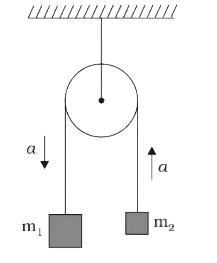Two bodies of different masses m1 and m2 have equal momenta. Their kinetic energies E1 and E2 are in the ratio
√m2m1
√m1m2
m1m2
m2m1
The correct Answer is:D
To solve the problem, we need to find the ratio of the kinetic energies E1 and E2 of two bodies with different masses m1 and m2 that have equal momenta.
1. Understand the relationship between momentum and kinetic energy:
The momentum p of an object is given by:
p=mv
where m is the mass and v is the velocity of the object.
2. Write the expression for kinetic energy:
The kinetic energy E of an object is given by:
E=12mv2
3. Express kinetic energy in terms of momentum:
We can express kinetic energy using momentum:
E=p22m
Thus, for the two bodies, we can write:
E1=p22m1andE2=p22m2
4. Set the momenta equal:
Since both bodies have equal momentum, we can denote this common momentum as p.
5. Substitute the expressions for kinetic energy:
Now, substituting the expressions for kinetic energies:
E1=p22m1andE2=p22m2
6. Find the ratio of the kinetic energies:
To find the ratio E1E2:
E1E2=p22m1p22m2=p22m1⋅2m2p2=m2m1
7. Final result:
Therefore, the ratio of the kinetic energies E1 and E2 is:
E1E2=m2m1
Conclusion:
The ratio of the kinetic energies E1 and E2 is m2m1.
The momentum p of an object is given by:
p=mv
where m is the mass and v is the velocity of the object.
The kinetic energy E of an object is given by:
E=12mv2
We can express kinetic energy using momentum:
E=p22m
Thus, for the two bodies, we can write:
E1=p22m1andE2=p22m2
Since both bodies have equal momentum, we can denote this common momentum as p.
Now, substituting the expressions for kinetic energies:
E1=p22m1andE2=p22m2
To find the ratio E1E2:
E1E2=p22m1p22m2=p22m1⋅2m2p2=m2m1
Therefore, the ratio of the kinetic energies E1 and E2 is:
E1E2=m2m1
The ratio of the kinetic energies E1 and E2 is m2m1.
Topper's Solved these Questions
- WORK, ENERGY AND POWERBOOK - DC PANDEY ENGLISHCHAPTER - WORK, ENERGY AND POWEREXERCISE - CHECK POINT 6.3
10 Videos
- WORK, ENERGY AND POWERBOOK - DC PANDEY ENGLISHCHAPTER - WORK, ENERGY AND POWEREXERCISE - EXERCISES(TAKING IT TOGETHER)
83 Videos
- WORK, ENERGY AND POWERBOOK - DC PANDEY ENGLISHCHAPTER - WORK, ENERGY AND POWEREXERCISE - CHECK POINT 6.1
20 Videos
- WORK, ENERGY & POWERBOOK - DC PANDEY ENGLISHCHAPTER - WORK, ENERGY & POWEREXERCISE - Level 2 Comprehension Based
2 Videos
- WORK, POWER AND ENERGYBOOK - DC PANDEY ENGLISHCHAPTER - WORK, POWER AND ENERGYEXERCISE - E Integer Type Questions
11 Videos
Similar Questions
Two bodies of masses m1 and m2 have equal KE. Their momenta is in the ratio
View SolutionTwo bodies of mass 1kgand2kg have equal momentum. The ratio of their kinetic energies is:
View SolutionTwo bodies of masses m1andm2 have same kinetic energy. The ratio of their momentum is
View SolutionTwo bodies of masses m1andm2(<m1) are connected to the ends of a massless cord and allowed to move as shown in figure. The pulley is both massless and frictionless. The acceleration of the centre of mass is (m1−m2)n(m1+m2)2g. Find the value of n.

View SolutionTwo bodies with masses m1kgandm2kg have equal kinetic energies. If p1andP2 are their respective momenta, then p1/P2 is equal to :
View SolutionTwo bodies with moment of inertia l1 and l2 (l1>l2) have equal angular momentum. If E1 and E2 are the rotational kinetic energies, then
View SolutionTwo bodies with moment of inertia I1 and I2(I1>I2) have equal angular momenta. If their kinetic energy of rotation are E1 and E2 respectively, then.
View SolutionTwo particles of masses m and 2m have equal kinetic energies. Their de Broglie wavelengths area in the ratio of:
View SolutionA stationary particle explodes into two particle of a masses m1andm2 which move in opposite direction with velocities v1andv2. The ratio of their kinetic energies E1/E2 is
View SolutionTwo masses of 1 g and 4g are moving with equal linear momenta. The ratio of their kinetic energies is :
View Solution
